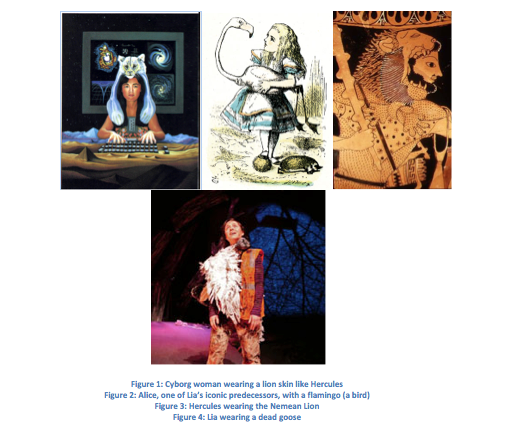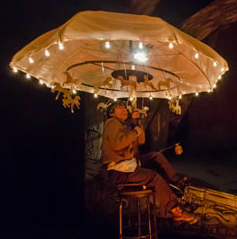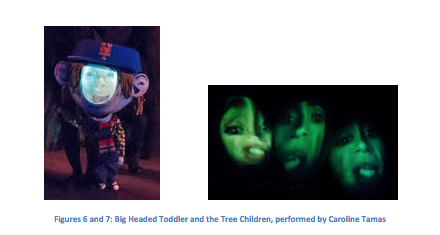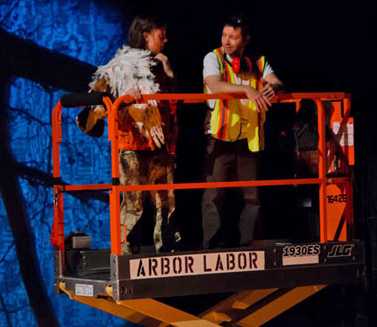BY JOSHUA BASTIAN COLE
“There might be a cyborg Alice taking account of these new dimensions.”
Donna Haraway, A Cyborg Manifesto
Cyborgs may bring to mind cold metallic human robot hybrids stomping around on a spaceship in a galaxy far, far away. The theory introduced by Donna Haraway in her influential 1991 manifesto brings cyborgs much closer to home. Haraway’s cyborgs are liminal beings that float between dualistic categories. Defined by Haraway as cybernetic hybrids of machine and organism, cyborgs are also both creatures of social reality as well as creatures of fiction. Tying the theory to feminism, Haraway clarifies that the cyborg is equally a matter of fiction and the non-fiction occurrences that change what counts as women’s experience. She writes, “This is a struggle over life and death, but the boundary between science fiction and social reality is an optical illusion.” In Erin Courtney’s play, The Service Road, produced by the Adhesive Theater Project’s residency at the New York City College of Technology, mixtures of human and mechanical tell the tale of a (cyborg) woman’s own struggle over life and death in a fictional tale set in a real location and inspired by an actual earthly event.
The story of The Service Road, like traditional fantastic journey fictions, begins on a seemingly normal day in the real world. The setting is Brooklyn’s Prospect Park, with nature guide, Lia (played by Kalle Macrides), preparing to give a tour of the park’s indigenous bird life. Before long, a storm blows through, as is wont to do in the history of the stage. Though inspired by the Brooklyn Tornado of 2010, this howler is reminiscent of both King Lear’s and Dorothy Gale’s personal storms. Amongst the detritus of the blustery catastrophe, Lia spots a small lost boy wandering through the park. Lia’s goal is to save the boy (and herself) by the end of the journey, but no trek on such a road as this one could be travelled smoothly. Lia becomes what Adhesive refers to as a “modern day Hercules” and encounters numerous trials on her (service) road to redemption.
Along the road, Lia encounters many colorful characters, most of them played by Cory Einbinder. The theatrical mode of an actor playing multiple characters, including fantasy alter egos, is another connector to mythical or fairy tale stories and dramas, including Alice in Wonderland, The Wizard of Oz, and Peter Pan. However, there are a few non-human characters Lia also happens upon video hybrid puppets. It would be too easy to look only at the video puppets and call this play a piece of cyborg theatre. The cyborg nature of the piece surpasses the transgressed boundaries of human/machine inherent to puppetry. Cyborgs are actually present in every character and in every part of the design from costumes, to sound, to set.
Every character in The Service Road is a cyborg, which can be seen in their costumes and props. Lia has her binoculars ready for nature tours of the park; Frank has a walkie talkie as a responsible park ranger; the High School Senior enters listening to music on a phone suiting his stereotype; Linus powers his precious carousel by grinding bicycle gears with his own legs; and Gus drives the giant cherry picker crane that ultimately serves as the most famous of theatre machines, a deus ex machina. In their own, less obvious ways than the puppets, everyone is part machine in this world, but some are more cyborg than others.
The puppets of the The Service Road, designed by Einbinder, utilize a video harness rig that the puppeteer, Caroline Tamas, wears while acting and voicing the characters live. When portraying the Big Headed Toddler, the audience sees Tamas wearing the rig while walking behind the puppet and manipulating its movements. Her face is projected from live video feed onto the face of the puppet, which simultaneously gives the puppet a living face, gives Tamas a hybrid/cyborg existence, and gives the audience a dual view of living machine and living human. In the cyborg universe, barriers between the living and the inanimate are blurred as are many other boundaries. Haraway lists such blurry dichotomies as self/other, mind/body, culture/nature, male/female, civilized/primitive, reality/appearance, whole/part, agent/resource, maker/made, active/passive, right/wrong, truth/illusion, total/partial, god/man. All of these dichotomies blur in The Service Road. The cyborg universe leaves a thoroughly ambiguous difference between the natural and the artificial, the physical versus the non-physical. The world of The Service Road is filled with hybrid actors, part person and part machine. The design is also a hybrid of live action and animated mixed media with live foley simulating natural sounds of birds and horses, blurring yet another line: the human/animal.
The cyborg identity is an outsider identity, and Lia, who the audience immediately learns is a strange girl, is certainly a social outsider before she goes on her Carrollian trek through dystopian Prospect Park. Frank, Lia’s boss, hired her out of charity, saving her from suicidal tendencies. Lia’s life has been marred by an experience in her youth that this odyssey in Prospect Wonderland absolves her of: the death of her half-brother, Jason. Lia begins by following the lost boy called Big Headed Toddler, akin to Alice’s absurd White Rabbit chase into Wonderland. Along Lia’s journey, she is judged by the Tree Children, Grecian Furies who know more about Lia than they should. She encounters Herculean tasks and eventually dons the garb of dead geese that plummet to the earth. This is not before becoming covered in human excrement by cleaning the Prospect Park public restrooms when they erupt post-storm, replicating Hercules’s famously impossible task to clean the Augean stables. Throughout the play, Lia reenacts the tasks of the demigod Hercules, who is also a cyborg in Haraway’s definition, being part god, part mortal.
Cyborgs are also removed from the sexualized reproductive essentialism historically placed on women. From the beginning to the end of the play, Lia evades any stereotypical placement for a female protagonist. Courtney gives the character every opportunity to become less and less sexualized, first by being covered in excrement, and then wearing the carcasses of dead animals. Lia is asked out by the lonely arbor man, Gus, and in response Lia explains she should probably not be with anyone. It is also to Gus that Lia confesses her sinful past in which she, accidentally or not, tragically murdered her younger step-brother Jason. Haraway’s cyborgs, being removed from necessary maternalism, further implicate Lia as a cyborg. Lia is an outsider with stunted maturity, and she is neither a mother nor motherly. On her journey through the Park, Lia is guided by non-human entities but encounters other humans with whom she shares very personal conversations, thus pulling her between the worlds of truth and illusion. As a Hercules character, she is part god. As literary allusion to Wonderland’s Alice, she is part fictional icon. Lia was a child who killed a boy, and a woman who saved a boy. Her actions, like a cyborg, sit between right and wrong and between loss and redemption.
Works Consulted
“Adhesive Theater Project.” Adhesive Theater Project. N.p., n.d. Web. 20 Feb. 2013. <http://www.adhesivetheater.com/>.
Feldman, Adam. “The Service Road.” Time Out New York, 2 Jan. 2013. Web. 23 Feb. 2013. <http://www.timeout.com/newyork/theater/the-service-road>.
Haraway, Donna. “A Cyborg Manifesto: Science, Technology, and Socialist-Feminism in the Late Twentieth Century.” Simians, Cyborgs and Women: The Reinvention of Nature. New York: Routledge, 1991. 149-81. Print.
Webster, Andy. “Charting a Dreamlike Journey, With Travels Both Outside and In: ‘The Service Road’ at the Voorhees Theater.” New York Times. 24 Jan. 2013. Web. 16 Feb. 2013.
Photos
Figure 1:
Foo, Lisa. Digital image. Internet Archive Wayback Machine. Stanford University, n.d. Web. 23 Feb. 2013.
Figure 2:
Alice and the Flamingos. Digital image. Alice in Wonderland Wikia. Wikia.com, n.d. Web. 23 Feb. 2013.
Figure 3:
Hercules Wearing the Lion Skin. Digital image. Hercules: Greece’s Greatest Hero. Tufts University – Photograph Courtesy, Museum of Fine Arts, Boston. H. L. Pierce Fund, n.d. Web. 23 Feb. 2013.4-8
Figures 4-8:
“Adhesive Theater Project.” Adhesive Theater Project. N.p., n.d. Web. 20 Feb. 2013. <http://www.adhesivetheater.com/>.




